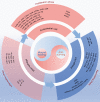Mesenchymal stem cell-derived extracellular vesicles in skin wound healing: roles, opportunities and challenges
- PMID: 37587531
- PMCID: PMC10433599
- DOI: 10.1186/s40779-023-00472-w
Mesenchymal stem cell-derived extracellular vesicles in skin wound healing: roles, opportunities and challenges
Abstract
Skin wounds are characterized by injury to the skin due to trauma, tearing, cuts, or contusions. As such injuries are common to all human groups, they may at times represent a serious socioeconomic burden. Currently, increasing numbers of studies have focused on the role of mesenchymal stem cell (MSC)-derived extracellular vesicles (EVs) in skin wound repair. As a cell-free therapy, MSC-derived EVs have shown significant application potential in the field of wound repair as a more stable and safer option than conventional cell therapy. Treatment based on MSC-derived EVs can significantly promote the repair of damaged substructures, including the regeneration of vessels, nerves, and hair follicles. In addition, MSC-derived EVs can inhibit scar formation by affecting angiogenesis-related and antifibrotic pathways in promoting macrophage polarization, wound angiogenesis, cell proliferation, and cell migration, and by inhibiting excessive extracellular matrix production. Additionally, these structures can serve as a scaffold for components used in wound repair, and they can be developed into bioengineered EVs to support trauma repair. Through the formulation of standardized culture, isolation, purification, and drug delivery strategies, exploration of the detailed mechanism of EVs will allow them to be used as clinical treatments for wound repair. In conclusion, MSC-derived EVs-based therapies have important application prospects in wound repair. Here we provide a comprehensive overview of their current status, application potential, and associated drawbacks.
Keywords: Engineered nanoparticles; Extracellular vesicles (EVs); Mesenchymal stem cell (MSC); Wound repair.
© 2023. People´s Military Medical Press.
Conflict of interest statement
The authors declare that they have no competing interests.
Figures








Comment in
-
Mesenchymal stem cell-derived extracellular vesicles in skin wound healing: the risk of senescent drift induction in secretome-based therapeutics.Mil Med Res. 2023 Nov 30;10(1):60. doi: 10.1186/s40779-023-00498-0. Mil Med Res. 2023. PMID: 38031201 Free PMC article. No abstract available.
References
Publication types
MeSH terms
LinkOut - more resources
Full Text Sources
Research Materials

